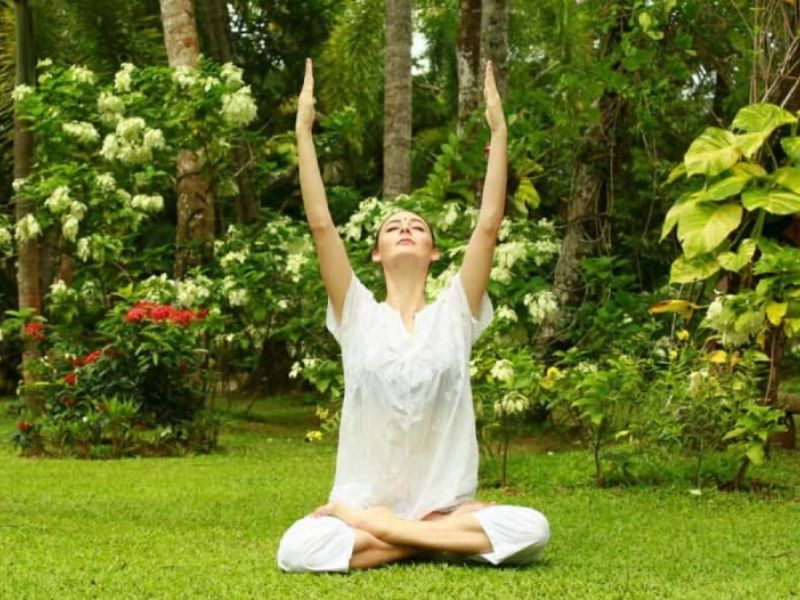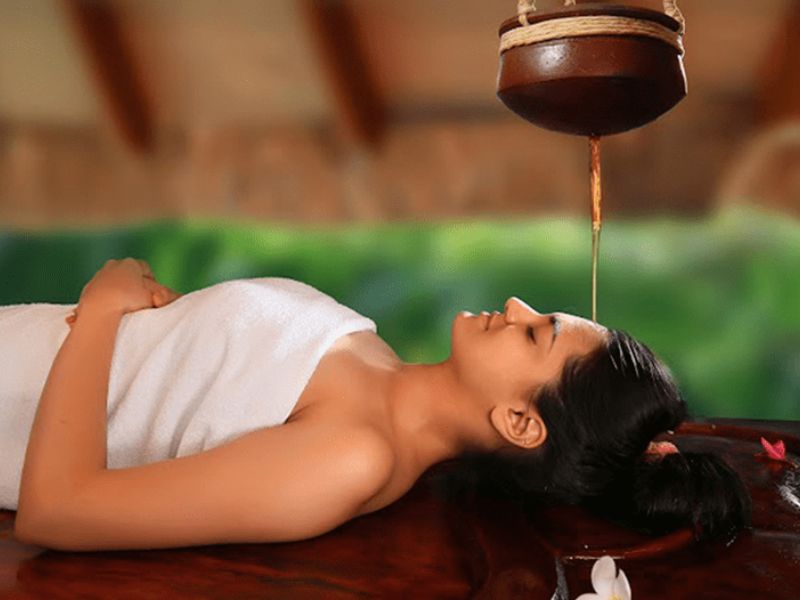DIET AND NUTRITION AT CARNOUSTIE
IMPORTANCE OF DIET IN AYURVEDA
“You are what you eat” is a saying that is taken very seriously in Ayurveda. The name ‘Ayurveda’ originates from two Indian words: ‘Ayur’, meaning life, and ‘Veda’ meaning knowledge or science. This oldest known "Science of Life” stresses that our diet or ‘ahara’ impacts both, our physical and emotional wellbeing and hence, is the first and foremost pillar of this science. There is a ‘sloka’ (writings of the ancient texts of ayurveda) that says “food is medicine when consumed properly.” And that improper diet produces toxins or ‘ama’ in the body which is the root cause of disease and ill health. From the curative perspective, while diet alone may not be the cure for all diseases, its proper intake can keep ailments away and under control.

THEORY OF FIVE ELEMENTS
(PANCHAMAHABHOOTA)
According to this theory all matter in this universe is composed of five basic elements- the
Pancha Mahabhootas, namely Earth (Prithvi), Water (jala ), Fire (agni), Air (vayu) and space
(akasha). These elements are the building blocks of our world and can be found in everything
around us in varying proportions. They combine in unique ways to create different
environments, a wide variety of flora and fauna including human beings. These five elements
also compose the food that we consume and hence their understanding is significant in making
effective diet and nutrition plans.
THEORY OF THREE BIOLOGICAL HUMORS
(TRIDOSHAS)
The human body and all flora and fauna around us are composed of the five elements or
Panchamahabhootas. Derived from this, Ayurveda identifies three different Doshas or body
types that have these five elements in varying proportions: Vata is made up of Vayu (air) and
Akasha (space) Mahabhoota, Pitta is made up of Agni (fire) and Jala (water) Mahabhootas and
Kapha is made up of Jala (water) and Prithvi (earth) Mahabhoota. Every individual’s body
composition has a different proportion of vata, pitta and kapha elements and this impacts his/her
physical, mental and emotional traits.

UNDERSTANDING THE DOSHAS
Have you ever wondered why each individual has different characteristic traits? Why some are
gregarious, while others are reserved and quiet? Why some people love food and can eat just about
everything, while others are poor eaters and dread food? Why are some people always happy and positive,
while some are melancholic and pessimistic? While genetics has its own explanation, Ayurveda explains
them through the understanding of the three doshas:Vata, Pitta andKapha. According to theAyurvedic
concept of prakriti (constitution), each one of us is born with a unique combination of vata, pitta, and
kapha dosha. This proportion at birth remains the personal reference point for optimal health and
determines our physical and mental self. We remain healthy as long as our bodies can maintain the
specific ratio of vata, pitta, and kapha that we were born with. However, any imbalance in this natural
proportion, leads to physical and mental disease. No particular dosha is superior to the other. Each one
has specific physical and emotional influences and are found in varying proportions in every individual.
This is the underlying reason behind the fact that no two individuals are identical. However, generally,
only one Dosha dominates an individual, but in some cases there might be an interplay of two together in
varying proportions. Thus,Ayurveda recommends that we seek expert help to identify our correct Dosha
or body type and make subtle lifestyle and dietary changes to suit it so that we can be healthy always.

THE THREE PRIMARY DOSHIC STATES
The Doshas are biological energies that govern all physical and mental processes and provide every
living being with an individual blueprint for health and achievement. They are found in the following
three states:
- Balanced: In this state all the three Doshas are balanced in their natural proportions.
- Aggravated: In this state one particular Dosha is in excess and dominates.
- Depleted: In this state one particular Dosha is present in less than normal proportion.
Of the three, the aggravated state is the worst and leads to imbalance and disease. An aggravated Dosha state can be the result of an imbalanced diet or a stressful lifestyle. Ayurveda offers an individualized treatment for each type or body condition which is very different from the western model’s “one-pill for all” approach. If detected on time, imbalanced Doshas can be cured by making alterations in diet and lifestyle. It is important to note that each Dosha type has its own specific dietary and lifestyle recommendations to keep it balanced and for this apparent reason, Ayurveda does not believe in a universal diet for all. Every individual should consume a diet compatible to his/ her predominant biological humors/doshas, to keep them in state of equilibrium in different seasons. This is both a preventive and curative approach to optimal health.

VATA DOSHA (WIND ENERGY)
Vata is primarily composed of the space (akasha) and air (vayu) elements. Intrinsically, the vata dosha is
dry, light, mobile, cold, subtle and clear like the characteristics of air and space. Vata is also called the
“King of the Doshas” because it is the energy of movement and governs all biological activity and gives the
body its life force.Aperson with a predominantlyVata constitution will have physical and mental qualities
that reflect the essential qualities of space and air and consequently, the Vata type of individuals are quick
thinking, thin and fast moving. The balanced Vata individual is energetic, artistic, articulate and
communicative. However, when the Vata type is disturbed then, like the hurricane effect it causes
imbalance and the person becomes restless and anxious. The bodily disorders related toVata imbalance are
dryness of the skin, digestive disorders and constipation, painful joints, hampered circulation and
movement.

PITTA DOSHA (FIRE ENERGY)
Pitta is made up of the Fire (agni) andWater (jal) elements. It has the qualities of being hot, sharp, light,
liquid and oily. Physiologically, Pitta provides the body with heat and energy through the breakdown of
complex food. It governs all processes related to transformation of energy throughout the mind and
body. Thus, it governs nutrition and metabolism and the body temperature. A Pitta type individual will
have qualities reflective of Fire and Water, such as a fiery personality and oily skin. Pitta is related to
intelligence, understanding, digestion, and transformation and it governs joy, courage, willpower, anger,
jealousy, and mental perception and intellect. The balanced Pitta individual is blessed with a joyful
disposition, a sharp intellect, and tremendous courage and drive. However, when Pitta is imbalanced it
leads to anger, rage, and ego leaving an individual who is bitter with life and haughty towards others.
There is a saying that imbalanced Pitta individuals don’t go to hell; they simply create it wherever they
go! Pitta imbalances leads to bodily disorders like infection, inflammation, ulcers, heartburn, and fever.

KAPHA DOSHA (WATER ENERGY)
Kapha is composed of the earth (prithvi) and water (jala) elements. It has the qualities of being heavy,
thick, slow, oily, moist and humid. Kapha lends structure and firmness to the physical body.
Physiologically, Kapha moistens the food, gives bulk to our tissues, lubricates joints, stores energy, and
makes up the cool bodily fluids such as water, mucous and lymph. A Kapha type individual has a sturdy
body structure/frame and a calm temperament, reflecting the underlying elements of Earth and Water.
Psychologically, Kapha governs love, patience, tranquility, compassion, greed, attachment and mental
inertia. When imbalanced it leads to depression and lethargy and this makes the body prone to obesity,
sinus congestion and ailments related to the mucous.
Soups
Salads
Main Course
Deserts
Juices
Collagen Smoothies
Herbal Drinks
Glutten Free
Our Programs
Wellness at Carnoustie
It's authentic ayurveda, marma, kalari treatments faithful to the lineage and legacy is unmatched. All regimens are customized to address an individual's specific needs, offering the guests a mind-body-spirit experience that is truly personal.
Detox (Panchkarma)
Is the most significant treatment for purification & detoxification in Ayurveda. It helps to remove...
Find Out MoreWeight Loss
Ayurveda, emphasises on a holistic solution that helps people lose excess weight, while also improving...
Find Out MoreAnti ageing
This programme involves result oriented treatments by integrating therapeutic Marma, Prana...
Find Out MoreRejuvenation
This is a unique therapy in the science of ayurveda. It keeps the body young and agile even after one...
Find Out MoreHealing
This programme is a unique amalgamation of therapeutic practices of Ayurveda, Yoga, Meditation...
Find Out MoreDiabetic Management
The yoga practices act in two different ways to manage diabetes. Firstly, the cells of the Islets of Langerhans...
Find Out MorePain & Injury Management
Most of the yoga postures have static stretching effect on the connected muscles and...
Find Out MoreSports Medicine
Sports medicine deals with physical fitness and the treatment of injuries related to sports and...
Find Out MoreGeriatric Care
Experience the synergy of Ayurveda and Yoga for graceful aging and an optimal quality of life.
Find Out MoreWomen's health care
Yoga and Ayurveda empower women's health through holistic practices and natural remedies.
Find Out More
































































